Shami finds the chink in Cook's armour
Virat Kohli's footwork, Wriddhiman Saha's misjudgement and a peach of a ball to Alastair Cook feature in Aakash Chopra's technical breakdown
Aakash Chopra
18-Nov-2016

Moeen Ali tended to bowl on a good or full length but his flat trajectory encouraged some to play back • ESPNcricinfo Ltd
Deciphering swing
The first ball of the day didn't move in the air but tailed back in after pitching. The seam was pointing towards third slip, which should have taken the ball away but it didn't. James Anderson is a great bowler because of his masterful wrist and one could easily assume that the ball in question came back in because he flicked his wrist at the point of delivery. But perhaps that wasn't the case, for an identical ball (same wrist and seam position) last night went away from Ajinkya Rahane. What's happening here? Is trusting the seam position to decipher the swing a bad choice? Anderson has a slightly open action for an outswing bowler and the moment he doesn't finish the action nicely, the ball doesn't move away in the air or off the pitch. It tends to happen at the start of a new spell. Remember the first ball after lunch on the first day? It drifted on to Virat Kohli's pads even when Anderson had 7 fielders on the off-side.
Kohli's footwork on the drive
When Kohli started as a young first-class batsman, he had a really short and across front-foot stride. He worked around it by playing the ball really late. But once in a while, he would find himself in a tangle because of the nature of his stride. If there's one thing that Kohli has changed it is his head position in the stance and that has not only led to a better understanding of where his off stump is but also allowed him to have a long forward stride as opposed to the earlier short and across stride. Nowadays, it's worth watching his front-foot defence and drives from the square angle, for it reminds you of his evolution as a batsman.
Saha's Moeen misjudgement
Wriddhiman Saha was lbw to Moeen Ali after went back to a ball that was not particularly short. There is something about Moeen that encourages you to go back, for he bowls a flatter trajectory and the moment a batsman sees the flatter line, he gets tempted to stay back. This error of judgement tends to happen more often when either you are new at the crease or Moeen is at the start of a new spell.

Mohammed Shami found the perfect line and length to Alastair Cook•ESPNcricinfo Ltd
Shami finds the sweet spot
Alastair Cook's trigger movement is really pronounced and takes him deep inside the crease. Whenever you see a batsman with such a trigger movement, it's believed that if you pitch the ball fuller, you will have him in a spot of bother. In theory it looks very simple but when you look at Cook's Test record, you realise that it isn't as simple after all. There are a couple of aspects to Cook's technique - since he is acutely aware of his off stump, he leaves the ball really well. So, if you pitch full and outside off, he is equipped to let them go. Then if you bowl a little too straight, you end up playing to his strengths, for he is really strong off his legs. Since his front-foot stride is either marginal or non-existent, he's also mindful of the fact that pushing hard with hands would land him in trouble. But once in a while, early on in his tenure, he will get an ideal delivery that dismisses him. Mohammed Shami found that length and line on the delivery that saw the back of Cook.
Root's response to variable bounce
The first ball of the seventh over stayed really low and Joe Root was fortunate to get his bat down in time. Once that happens to you, you try and play everything off the front foot with a vertical bat but it's easier said than done against bowlers operating close to 90 mph. It is also tough to forget about years of conditioning with regards to your response against the short ball. Root decided to do something spectacular on the following ball - he stepped down the pitch and flicked it for four. It's rare to see that in the seventh over of a new Test innings but the idea was to be proactive instead of waiting for the next ball to stay low.
Aakash Chopra is the author of three books, the latest of which is The Insider: Decoding the craft of cricket. @cricketaakash